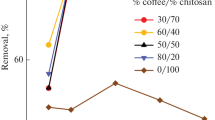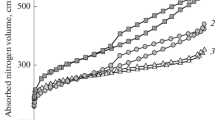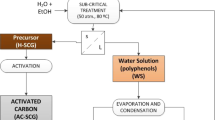Abstract
The waste coffee-grounds carbon (WCGC) was prepared with H3PO4 treated using waste coffee-grounds as precursor. Its adsorption ability was studied using phenol as test molecule. The influence of H3PO4 treated, calcined temperature, the initial phenol concentration, the doge of carbon and original pH values on phenol adsorption ability were investigated. Characterization of WCGC was performed by N2 adsorption isotherms, Fourier transform infrared spectroscopy (FT-IR), scanning electron microscopy (SEM), and X-ray diffraction (XRD) techniques. First, the second order and Weber-Morris model reaction rate models were used to estimate the WCGC adsorption ability. The results show that the produced WCGC (700 °C, 2 h) has been graphitized and the layered structure increased BET surface to 435.98 m2/g and adsorption phenol ability. The initial phenol concentration is 50 mg/L, the amount of WCGC (700 °C, 2 h) is 0.2 g, and the phenol adsorption rate is 97% after 270 min and no intermediate product formation. The adsorption kinetics of the selected WCGC is best fitted by the Weber-Morris model.
Similar content being viewed by others
References
Saha N C, F Bhunia, Kaviraj A. Toxicity of Phenol to Fish and Aquatic Ecosystems[J]. Bulletin of Environmental Contamination and Toxicology, 1999, 63(2): 195–202
Ahmed S, Rasul M G, Martens W N, et al. Heterogeneous Photocatalytic Degradation of Phenols in Wastewater: A Review on Current Status and Developments[J]. Desalination, 2010, 261(1–2): 3–18
Magdalena, Diak, Marek, et al. Photoactivity of Decahedral TiO2 Loaded with Bimetallic Nanoparticles: Degradation Pathway of Phenol-1-13C and Hydroxyl Radical Formation[J]. Applied Catalysis B Environmental, 2017, 200: 56–71
Villegas L, Mashhadi N, Chen M, et al. A Short Review of Techniques for Phenol Removal from Wastewater[J]. Current Pollution Reports, 2016, 2(3): 1–11
Serafin J, Baca M, Biegun M, et al. Direct Conversion of Biomass to Nanoporous Activated Biocarbons for High CO2 Adsorption and Supercapacitor Applications[J]. Applied Surface Science, 2019, 497: 143 722
Freitas A. Phenol Removal via Advanced Oxidative Processes (O3/Photo-Fenton) and Chemometrics[J]. American Journal of Theoretical and Applied Statistics, 2013, 2(6): 243–247
Vargas A, Cazetta A L, Kunita M H, et al. Adsorption of Methylene Blue on Activated Carbon Produced from Flamboyant Pods (Delonix Regia): Study of Adsorption Isotherms and Kinetic Models[J]. Chemical Engineering Journal, 2011, 168(2): 722–730
Koen S, Mats D J, Iwona L, et al. Rapeseed and Raspberry Seed Cakes as Inexpensive Raw Materials in the Production of Activated Carbon by Physical Activation: Effect of Activation Conditions on Textural and Phenol Adsorption Characteristics[J]. Materials, 2016, 9(7): 1–19
Efremenko I, Sheintuch M. Predicting Solute Adsorption on Activated Carbon: Phenol.[J]. Langmuir the Acs Journal of Surfaces & Colloids, 2006, 22(8): 3 614–3 621
Wang Z, Shen D, Wu C, et al. State-of-the-art on the Production and Application of Carbon Nanomaterials from Biomass[J]. Green Chemistry, 2018, 20: 5 031–5 057
Benzigar, Mercy R. Recent Advances in Functionalized Micro and Mesoporous Carbon Materials: Synthesis and Applications[J]. Chemical Society Reviews, 2018, 47: 2 680–2 721
Lee Y S, Thangavel R, Kaliyappan K, et al. Engineering the Pores of Biomass-Derived Carbon: Insights for Achieving Ultrahigh Stability at High Power in High-Energy Supercapacitors[J]. Chemsuschem, 2017, 10: 2 805–2 815
Song S, Gu P, Chen Z, et al. Removal of U(VI) by Acid-Oxidized Biochar: Batch Experiments and Spectroscopy Study[J]. Scientia Sinica Chimica, 2019, 49(1): 155–164
Gundogdu A, Duran C, Senturk H B, et al. Adsorption of Phenol from Aqueous Solution on a Low-Cost Activated Carbon Produced from Tea Industry Waste: Equilibrium, Kinetic, and Thermodynamic Study[J]. Journal of Chemical & Engineering Data, 2012, 57(10): 2 733–2 743
Boonamnuayvitaya V, Sae-Ung S, Tanthapanichakoon W. Preparation of Activated Carbons from Coffee Residue for the Adsorption of Formaldehyde[J]. Separ. Purif.Technol., 2005, 42(2): 159–168
Namane A, Mekarzia A, Benrachedi K, et al. Determination of the Adsorption Capacity of Activated Carbon Made from Coffee Grounds by Chemical Activation with ZnCl2 and H3PO4[J]. Journal of Hazardous Materials, 2005, 119(1–3): 189–194
Lessa E F, Nunes M L, Fajardo A R. Chitosan/Waste Coffee-Grounds Composite: An Efficient and Eco-friendly Adsorbent for Removal of Pharmaceutical Contaminants from Water[J]. Carbohydrate Polymers, 2018, 189: 257–266
Wan D, Wu L, Liu Y, et al. Enhanced Adsorption of Aqueous Tetracycline Hydrochloride on Renewable Porous Clay-Carbon Adsorbent Derived from Spent Bleaching Earth via Pyrolysis[J]. Langmuir., 2019, 35(11): 3 925–3 936
Jie T, Li Z, Mu B, et al. Attapulgite/Carbon Composites as a Recyclable Adsorbent for Antibiotics Removal[J]. Korean Journal of Chemical Engineering, 2018, 35: 1 650–1 661
Ugurlu M, Kula I, Karaoglu M H, et al. Adsorption of Cd(II) Ions from Aqueous Solutions Using Activated Carbon Prepared from Olive Stone by ZnCl2 Activation[J]. Environmental Progress & Sustainable Energy, 2010, 28(4): 547–557
Egle Rosson, Francesco Garbo, Giovanni Marangoni, et al., Activated Carbon from Spent Coffee Grounds: A Good Competitor of Commercial Carbons for Water Decontamination[J]. Applied Sciences, 2020, 10(16): 5 598
Anirudhan T S, Sreekumari S S, Bringle C D. Removal of Phenols from Water and Petroleum Industry Refinery Effluents by Activated Carbon Obtained from Coconut Coir Pith[J]. Adsorption-journal of the International Adsorption Society, 2009, 15(5–6): 439–451
Chen X, Sun H, Zhang J, et al. Synthesis of Visible Light Responsive Iodine-Doped Mesoporous TiO2 by Using Biological Renewable Lignin as Template for Degradation of Toxic Organic Pollutants[J]. Applied Catalysis B: Environmental, 2019, 252: 152–163
Shaban Y A, Sayed M, Maradny A, et al. Photocatalytic Degradation of Phenol in Natural Seawater Using Visible Light Active Carbon Modified (CM)-n-TiO2 Nanoparticles under UV Light and Natural Sunlight Illuminations[J]. Chemosphere, 2013, 91(3): 307–313
Bahrudin N N, Nawi M A. Fabrication of Immobilized Powdered Activated Carbon as Asub-Layer of TiO2 for the Photocatalytic-Adsorptive Removal of Phenol[J]. Reaction Kinetics, Mechanisms and Catalysis, 2017, 124: 153–169
Cheng G, Xu F, Xiong J, et al. Enhanced Adsorption and Photocatalysis Capability of Generally Synthesized TiO2-carbon Materials Hybrids[J]. Advanced Powder Technology, 2016: 1 949–1 962
Mohammed N A S, Abu-Zurayk R A, Hamadneh I, et al. Phenol Adsorption on Biochar Prepared from the Pine Fruit Shells: Equilibrium, Kinetic and Thermodynamics Studies[J]. Journal of Environmental Management, 2018, 226(15): 377–385
Luo Y, Li D, Chen Y, et al. The Performance of Phosphoric Acid in the Preparation of Activated Carbon-Containing Phosphorus Species from Rice Husk Residue[J]. Journal of Materials Science, 2019, 54: 5 008–5 021
Puziy A M, Poddubnaya O I, Martnez-Alonso A, et al. Synthetic Carbons Activated with Phosphoric Acid: I. Surface Chemistry and Ion Binding Properties[J]. Carbon, 2002, 40(9): 1 493–1 505
Xiancheng Ma, Liqing Lia, Ruofei Chen, et al. Porous Carbon Materials Based on Biomass for Acetone Adsorption: Effect of Surface Chemistry and Porous Structure[J]. Applied Surface Science, 2018, 459: 657–664
Snoeyink V L, Weber W J, Mark H B. Sorption of Phenol and Nitrophenol by Active Carbon[J]. Environmental Science Technology, 1969, 3(10): 918–926
Yousef R I, El-Eswed B, Al-Muhtaseb A H. Adsorption Characteristics of Natural Zeolites as Solid Adsorbents for Phenol Removal from Aqueous Solutions: Kinetics, Mechanism, and Thermodynamics Studies[J]. Chemical Engineering Journal, 2015, 171(3): 1 143–1 149
Mohammed N A S, Abu-Zurayk R A, Hamadneh I, et al. Phenol Adsorption on Biochar Prepared from the Pine Fruit Shells: Equilibrium, Kinetic and Thermodynamics Studies[J]. Journal of Environmental Management, 2018, 226(15): 377–385
Funding
Funded by Yunnan Provincial Agricultural Joint Project (No.2018FG001-051), and Yunnan Provincial Department of Education Research Fund (No. 2020Y0414)
Author information
Authors and Affiliations
Corresponding author
Rights and permissions
About this article
Cite this article
Li, H., Zhang, J., Li, F. et al. Preparation of Waste Coffee-grounds Carbon and Study on Phenol Adsorption Ability. J. Wuhan Univ. Technol.-Mat. Sci. Edit. 37, 38–46 (2022). https://doi.org/10.1007/s11595-022-2497-z
Received:
Accepted:
Published:
Issue Date:
DOI: https://doi.org/10.1007/s11595-022-2497-z




